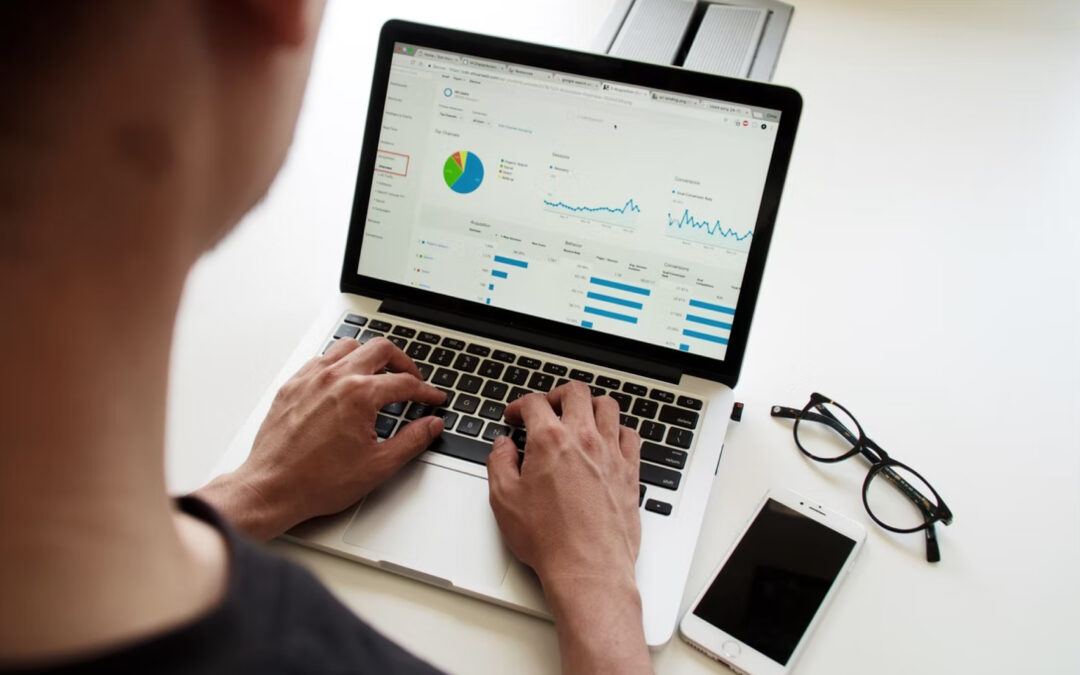
by threshold | Aug 12, 2022 | Design, Digital Marketing, Marketing, Tech/Web, Thought Leadership
 Anooj Francis
Anooj Francis
How does website development impact lead generation?
Did you know that in today’s digital age, over 90% of prospective renters and homeowners begin their search for a new home online? Miles before most people decide to contact a realtor, online searches are the most common way to discover available properties. How are these properties found so easily? Strong website design and development.
When building a real estate website, there are two significant aspects to consider: your customers and search engines. When prospective customers search for properties, you need a well-optimized website to show up on Google or other search engines. Though, you can’t just leave it at that; you also need a well-designed and user-friendly website so customers can find their desired future home quickly and efficiently.
Additionally, websites are able to do the work when humans are not. Unlike landlords, property managers, and real estate agents, websites don’t have office hours. A prospective renter or homeowner could visit your website at any time, of any day, of any week. Let’s not forget, websites allow you the chance to brand your company as well as your properties. First impressions can be tough, but when it comes to having a well-developed website, the first impression of your property will always be a positive one.
Don’t forget, your website is a way for you to not only showcase your real estate properties but also your organization. Include a section that can showcase all of your accomplishments, and show why you and your properties should be chosen over the competition. Any awards, client testimonials, and other ways to (tastefully) brag on your success is a great way to subtly set you aside from the crowd.
Why is optimized web design important during website development?
Nearly 80% of prospective renters will sign a lease without ever visiting the property. You read that right – without visiting the property. What makes them so sure about making such a commitment? Having all of the information they need right at their fingertips. High resolution photos, videos, and offering virtual tours are more often than not the deciding factors for prospective renters when it comes to committing to a lease. None of this could be done, however, without an optimized website design.
When we talk about optimized site design, we’re referring to the design process that is used during development which allows the site access to prime optimization for search engines such as Google and Bing. It also covers the on-page SEO best practices designers and developers must follow when building websites.
Think about it: how can you expect to generate leads online without a website strong enough to rank on the first page of the SERP (search engine results page)?
Any traffic to your website that is not the result of paid advertising is referred to as organic traffic. These are customers who landed on your site after performing a Google search based on its suggested results. Referencing an article from Smart Insights, the top ranked search result receives nearly 40% of all organic traffic clicks, followed by the second result at only 18.4% – less than half of what the first listed website receives. The third search result? Only 10% of clicks.
Ask yourself: when you’re conducting your own Google search, where do you start?
Because there are an astronomical amount of real estate websites out there to choose from, the challenge for many website owners and developers alike is finding a balance between user-friendly and SEO-friendly websites. Many organizations have independent teams for web development and digital marketing, which – while often formed with good intentions – can sometimes further complicate matters if not handled properly.
While the goal of the digital marketing team is to ensure the site has enough content for Google to rank it effectively for user search queries, the development team focuses on keeping the visual and user aspects of the site as simple as can be. Collaboration is only possible in companies that know the importance of digital marketing even before the site is designed. At companies like Threshold, the marketing team and the development team work hand in hand to give valid inputs to be considered at the time of creation.
How does Threshold Agency develop well-optimized websites?
If someone is searching for a specific floor plan in your area, how can you ensure that your listing will populate first in the Google search results? There are a few ways we can help with that. At Threshold, we know high-intent organic traffic is more valuable than any other traffic form, which is why we develop highly optimized websites to increase search engine rankings leading to more high-quality leads.
During the discovery phase, the marketing and creative teams ensure that we are creating websites that work well and are easy for visitors to navigate so they can find the information they’re looking for.
The designers will then take that information and design the website based on the ideas evolved from the discovery phase. Included in this second phase, a writer from our creative team will develop the website copy, which focuses on the target audience and a high-intent, high-quality organic keyword strategy.
Once completed with the second phase of development, the designers pass on their design to the developers. In this stage, the developers ensure everything the designers envisioned is working effectively with the site’s optimization so as not to cross the search engine boundaries.
To give you more of a focus, here are a few areas that our developers make sure to optimize during the early stages of development that impact the final rankings of a website in a search engine.
Website Speed
One of the most critical factors of Google page ranking is website speed, simply due to the fact that no one likes a website that takes an extended period of time to load. Anything past a couple of seconds and most users will bounce to a new site. To help decrease load time, our developers optimize the file sizes (images, videos, scripts), only use trusted plugins, and use an advanced caching system from the host site.
Mobile Responsive Design
Based on an article from CNBC, in the next three years, 3/4 of the world will use mobile devices to access the internet. A responsive website ensures your target audience has a seamless experience whether they are browsing your site from a computer or mobile device. This also helps to boost your search engine ranking, seeing as Google promotes mobile-friendly websites above those that are only desktop friendly. With 3/4 of the world moving to only using mobile devices, can you blame them?
As the website is created, run data scans and collect metrics through each phase of the development process. This allows for any changes to the website’s design or coding to remain monitored.
Sitemaps
Even though search engine bots are brilliant, it’s a good idea for us to point them in the right direction, and we do this through sitemaps. Sitemaps include all of the indexable web pages and links on a website. If we have a sitemap declared in the robots.txt, the search engine bots will first crawl through those pages. Simply said, if search engines are not finding your pages, this means means that organic traffic won’t find your pages. And as we said earlier, organic traffic is the most important traffic you want reaching your website.
Accessibility
While getting customers to the website is the main focus of an optimized site, many forget that the website needs to be accessible by everyone. At Threshold, we use Google Tools and User Way to ensure the website meets all the accessibility standards. This means your site is easily ready and accessible for people with physical and situational disabilities, as well as socioeconomic restrictions on bandwidth and website speed.
Indexable Content
Nowadays, in the web industry, we say content is king. Search engines use more AI technologies to crawl through the entire content of websites. If it can’t be crawled, it is not an SEO-friendly site. It means the likelihood of that page appearing in the search engine results is very low. At Threshold, creative writers write content for the targeted audience, and developers use the WordPress editor to apply the content where the content is in HTML and is easily indexable by search engines like Google.
The key to creating a well-optimized site is to bridge the gap between web development and search engine optimization. The collaboration between various teams from the start ensures that your website is fully optimized for SEO and usability. Providing value for customers is the key to impressing search engines. Where there is high-quality content, strong on-page SEO and excellent user experience, you will improve your presence on the internet and increase qualified leads.
In Conclusion
As the need for strong digital marketing in real estate increases seemingly by the day, so does the need for having a well-developed website. Today, real estate website optimization is so much more than metrics on a chart, it translates directly into potentially hundreds, if not thousands, of new leads.
So, ask yourself: are you confident in your real estate website?

by threshold | Jul 15, 2022 | Creative, Digital Marketing, Marketing, Thought Leadership
 Mai Mongelous
Mai Mongelous
We often think of a brand as just a logo and the name of a business. However, while a name and a logo are important visual elements for brand recognition and customer loyalty, it only scratches the surface of what branding can really involve. A brand strategy must be integrated in all aspects of marketing and development in order to create brand awareness, and to stand out from competitors.
The following are the 3 main brand components that are essential to address when building out your brand, and what types of strategies can be put in place to further develop these components.
A Strong Brand Identity
Create a meaningful visual identity: This consists of your overall brand image including logo, brand colors, website, and any other visual marketing materials. It represents the “look and feel” of your brand. This is the visual representation of what your clients will remember.
Consider your colors carefully – different colors have different meanings, and the colors you choose can speak to a specific target audience, resulting in various psychological impacts. As an example, many fast-food restaurants use red and yellow, because that combination of colors is thought to stimulate the appetite. Once chosen, ensure that you use consistency throughout all materials. (Always use the same typefaces, colors, brand patterns, etc.)
Questions to consider:
- Is this unique enough to stand out from competitors?
- Is it just a current trend, or will the design be timeless?
- What is the meaning of the logo (icon, font, color)?
- How will this resonate with the target audience?
Identify your mission: What is the business goal, and how does it reflect who you are?
Establish a Unique Value Proposition (UVP): This is a statement of how you will benefit your customers, how you will meet their needs, and why your offer is unique.
Increase your brand recognition: Think about different marketing methods such as building on different platforms and creating content that is optimized for SEO. Be sure to consistently add and improve upon new, fresh content under your brand guideline.
A Strong Brand Image
A brand image is similar to your brand identity. The key difference is, rather than how you want your brand to be perceived, your brand image is how your brand is actually perceived. Your brand image is like the reputation you have with the public.
Ways to build and maintain a positive brand image:
Establish a consistent social presence: Use social media platforms to engage with your customers, and keep them up to date on the latest news and product launches or programs. Engagement on a personal level can lead to increased overall customer service satisfaction.
Create innovative and high quality content: Content helps increase brand awareness by bringing in more web traffic while building your brand authority. You will become a trustworthy source of information, which will result in improving your reputation and increase brand trust.
A Strong Brand Culture + Brand Personality
Brand culture refers to your company’s core values and what you do everyday to live by those values. To establish a strong brand culture, consider the following:
- Define your values: What exactly are those values?
- Spread awareness of your values: Let your clients know what they are by promoting them
- Ensure that your company is always reflecting those values (Always practice what you preach!)
In order to have a strong brand culture, your brand personality is an important factor in connecting with your audience on an emotional level as well as making your brand relatable to your customers.
In order to keep a consistent brand personality, consider these questions:
- Learn who your audience is exactly; what is their age and location?
- Be consistent in your tone; is it playful and bold, or mature and sophisticated?
To wrap up, a strong brand requires a strong brand identity, a strong brand image, and a strong brand culture and personality. By implementing these in your brand strategy, it will increase loyalty, trust, and awareness, and your brand will always continue to grow. In real estate, it is crucial to building a brand that will differentiate you from your competitors.
So the question is – how will you create a strong and impactful brand?

by threshold | Jun 27, 2022 | Digital Marketing, Marketing, Tech/Web, Thought Leadership
For some, real estate marketing can feel like a shot in the dark; throwing money at separate tactics, crossing your fingers, and praying to whatever deity you believe in that people see your ads and there will be a line of a thousand future tenants at your leasing office’s doorstep the next morning.
Fortunately, it doesn’t have to be that way. A Business intelligence (BI) tool leverages technology to allow your team to collect, prepare, visualize, analyze, and present your performance data across all marketing channels. These insights help inform several types of business decisions, allows you to optimize your budget in the most efficient way possible, and improves marketing processes and outcomes.
So why should your business invest in a BI tool? Let’s go over the main benefits a little more in detail:
Identify trends and recognize opportunities
With a BI tool, you have the ability to splice, drill down and analyze large amounts of data at the few clicks of a button. This gives you full visibility into your marketing campaigns as well as allows you to derive external insights such as current events and the economy that may be affecting performance.
With regular analysis of both campaign performance and external factors, your team essentially creates a self-optimizing feedback loop that continually improves your campaigns over time.
Determine how to allocate spend
It’s hard to know how to allocate marketing spend when your current view of your data is limited by factors such as time, metrics, attribution, or visualization features that prohibit you from extracting valuable insights. When using BI for marketing, you can assess which tactics drove leads—both in quality and quantity—and which tactics didn’t.
When you assess which strategies were effective and which weren’t, you can optimize your investment by shifting your budget towards the most effective methods and away from those that underperformed.
Understand your audience
As you begin to collect more data and create more robust dashboards and reports, you will begin to get to really know the types of future tenants to go after with your marketing efforts. Using BI, you can begin to understand your audience’s demographic characteristics, their interests, the technologies and platforms they use, and so much more.
This will give you a better idea of what messaging and imagery to incorporate into your ads that will resonate with your target audience.
Improve internal efficiencies
Not only can you use business intelligence to make your marketing spend more efficient, but you can also use it to detect inefficiencies within your internal processes. Project management tools often provide limited insights into how your company is spending its time and what it’s spending it on. Once you pipe the data from your project management tool into your BI dashboard or report, you will be able to extract custom insights around inefficiencies within your internal processes. As you uncover and address more of these insights, your marketing processes will become more efficient, improving your overall return on marketing investment (ROMI).
An advantage over competitors
There’s a good chance that some of your competitors are already leveraging business intelligence to identify and target the same potential tenants that you are. Investing in BI will not only level the playing field but potentially surpass them as well as any competitors who haven’t yet made that investment.
Revenue growth
Ultimately, leveraging a BI tool helps you drive revenue and reach your leasing goals faster. As you make better decisions and continually improve your processes, you’ll see improved results from your marketing.
Now that you understand the benefits, it’s time to go out and implement your tool of choice. Looker, Tableau, PowerBI, and Domo are all tried and true options. No matter what the tool, you’ll want to identify your goals in using it, set up processes for collecting your data from various sources, and begin organizing it into dashboards and reports for your team to analyze. Business intelligence is an ongoing process. As you extract more interesting and valuable insights, your reporting and visualization needs may change and you will continue working through these steps and refining your techniques.
Congratulations, your team can now begin to make truly data-driven decisions. The insights that were once difficult, impossible, and/or time-consuming to gain are now readily available at your fingertips. Your team is now able to take action much much faster on valuable insights, increasing your ROMI and leasing up your property in a much faster and more efficient manner.

by threshold | Nov 2, 2021 | Digital Marketing, Marketing, Tech/Web, Thought Leadership
 Written by Michael Smart, Digital Strategist
Written by Michael Smart, Digital Strategist
The world of digital apartment marketing is a constantly evolving, confusing, and sometimes even chaotic one. Staple advertising platforms like Google and Facebook are changing their UI or adding new features on an almost monthly basis. New extensions, targeting capabilities (or limitations, thanks to updates like those introduced by iOS 14) are constantly changing, making it difficult to know what’s resulting in leads and what isn’t.
But outside of diving into the individual platforms and looking at the performance from a siloed point-of-view, how do you know if all of these efforts are working? What does your combined Cost Per Acquisition look like across all platforms on a month-over-month basis? How does your performance compare to this month last year, when the scramble to find housing began to slow down? More importantly, how can you prove to stakeholders or property managers that their marketing dollars are being spent wisely?
This is where developing a digital marketing performance report comes into play. A digital marketing performance report can come in the form of a dashboard or recurring static report that marketing strategists, managers, and property owners alike can use to quickly analyze campaign performance, spot trends, and optimize where needed.

First, sit down with relevant stakeholders and discuss what information and metrics are most valuable to you and your team. While this should ultimately result in multiple dashboards updating in real time and automated reports that are relevant for different teams, we suggest starting small and defining what metrics have the biggest impact determining performance and ultimately, attracting new tenants to your property.
Here are a few basic cross-platform metrics that should be included in your performance report:
- Impressions
- Conversions
- Conversion Type (Applications, Calls, Contact Forms, etc)
- CTR (Click-Through-Rate)
- CPA (Cost Per Acquisition)
The fun doesn’t end there though. It’s important to add as much context to these metrics as possible. For example, if your Search campaign has a 15% CTR, what does that actually mean? How does that compare to the same month last year? How does it compare to last month? How does it compare to benchmark in the same “subvertical” (i.e. Student Housing, Conventional, etc.)?

While all of these questions can be answered in the form of pretty looking graphs and charts, the most important thing is to identify any outliers that need immediate attention. Set up some conditional formatting that highlights your campaigns that are performing in the bottom 15th percentile. Identify campaigns that have 0 conversions over a certain period of time, or after spending a certain percentage of budget.
If you can add as much context as possible to a campaign’s performance and back it up with as many data points as you can that make sense, this will allow for your digital apartment marketing team to quickly decipher what’s going on and where optimizations can be made. The more context you add, the quicker and more accurate the analysis. The quicker and more accurate the analysis, the more optimized your ROMI (Return On Marketing Investment) is and the quicker your property becomes leased up by happy tenants (hopefully). Who knew data could be so much fun!

 Anooj Francis
Anooj Francis

 Mai Mongelous
Mai Mongelous

 Written by Michael Smart, Digital Strategist
Written by Michael Smart, Digital Strategist
